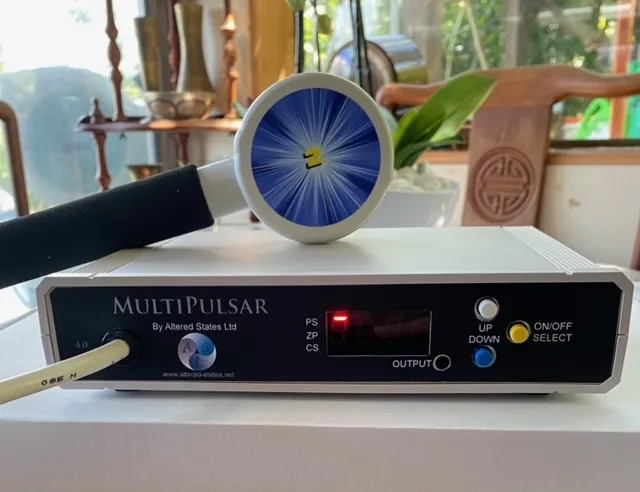PEMFs and the eyes
Much of the research on the use of magnetic fields in eye disorders has
come from Eastern Europe.
In one study, courses of rotating PEMF therapy (MT) were given using a
device of a 33 mT [330 Gauss] magnetic field, rotation frequency of 1.0
to 1.5 Hz, to 31 patients (43 eyes) for 10 min with primary open-angle
glaucoma, over 10 sessions. Untreated eyes (n = 15) of the same patients
were controls. The patients were examined before and 4 to 5 months after
MT. Vision acuity improved by 0.16 diopters, on average, in 96.7% of the
treated people who had vision acuity below 1.0 diopter before treatment.
By way of comparison, mild myopia [shortsightedness] could have a loss
1.00 to 3.00 diopters, while over the counter reading glasses will be rated
at +1.00 to +3.00 diopters. MT brought about an improvement of spatial
contrast sensitivity by at least 7 of a possible 12 levels in 85% of 26
eyes assessed. After PEMFs, visual field deficits decreased by at least
10% in 72% of 43 eyes versus controls and decreased by 22% vs. the initial
value overall in those treated. After 4 to 5 months the treatment changes
in the vision acuity and visual field deficit were negligible, in other
words the results were stable even after 4 – 5 months. In controls
the parameters showed no improvement over the entire follow-up period.
Bisvas Shutanto Kumar, Listopadova NA. Possibilities of magnetotherapy in stabilization of visual function in patients with glaucoma. Vestn Oftalmol. 1996 Jan-Mar;112(1):6-8.
In a different study, a different device, that is, a “traveling” magnetic field device, similar to the Almag, was used to treat primary open-angle glaucoma (POAG). In a traveling magnetic field device each coil is turned on sequentially in a series repeatedly. That creates a wave or stream -like action in the tissues, thought to be more activating. The PEMF was applied in patients to the cervical spine in the area of the sympathetic ganglia. Vascular flow and pressure parameters were analysed along with visual evoked potentials, visual fields, and visual acuity. They found that magnetic field therapy produces better clinical results in patients with stage I and II POAG compared with medication (using trental tablets).
Magnetotherapy designed to affect cervical sympathetic ganglia for the treatment of patients with primary open-angle glaucoma. Veselova EV, Kamenskikh TG, Raigorodkii IuM, Kolbenev IO, Myshkina ES. Vopr Kurortol Fizioter Lech Fiz Kult. 2010 Sep-Oct;(5):21-4.
Another group studied the influence of PEMF on the flow of fluid of the eye in POAG. They used a rectangular pulse form at a frequency of 50 Hz, 8.0-8.5 mT (80-85 gauss) intensity. The duration of the procedure was 7 minutes for a total of 10 sessions. 150 patients (283 eyes) were evaluated. Latent, initial and advanced glaucoma all benefited from the use of PEMFs. There was an increase in the amount and flow of fluid through the outflow canals of the front part of the eye [anterior chamber]. In the latent stage of glaucoma, outflow became normal in 25% of cases. At the initial and advanced stages 17.8% and 16.0% of cases, respectively, became normal. The authors concluded that they could recommend this method of treatment of open-angle glaucoma.
Tsisel’skii IuV. Oftalmol Zh. 1990;(2):89-92. The effect of a pulsed electromagnetic field on ocular hydrodynamics in open-angle glaucoma.
Research evaluated the possible mechanisms for improvement seen in retinal function. The effectiveness of PEMF therapy is not the same in all patients. The benefits from PEMF treatment for 15-30 min usually last only for 8-10 days, consistent with the time to renew rod pigments in the retina. In addition, visual examination of the back of the eye after electromagnetic treatment reveals dilation of the capillaries. Hence, one conclusion is that the favorable effect of PEMF therapy was from improvement of microcirculation. They found that retinal circulation gradually increased from arterioles to capillaries and venules. It appears that the authors concluded that the conditions for retinal rod pigment restoration in the central area of the retina are less favorable than in its peripheral areas. Therefore, the therapeutic effect in patients with loss of vision in the central area of the retina will occur after a greater number of PEMF stimulation sessions.
A possible mechanism of retina dystrophy treatment by electromagnetic field. Shlygin, V. V.; Arnautov, L. N.; Maksimov, G. V. Biofizika 38(3):507-510, 1993.
A PEMF system was used in the treatment of 283 eyes (177 patients) with macular damage of the retina. The treatment had a positive influence on the pathologic process in the eye, with stability of the benefit after treatment. In 152 eyes, visual acuity remained unchanged, improved in 131 (46%). Stabilization of the process was confirmed by objectively measured improvement indices. In 72 eyes, the results of treatment were followed up for 6 yr, confirming the effectiveness of this method of treatment. Long-term observations have found the need to repeat the course of treatment every 3-5 months (within a year) to prevent progression of the damage. Unfortunately we do not have information on the characteristics of the magnetic system used. Nevertheless, this study demonstrates the need for longer-term treatment to get sustainable results. When one considers the length of time it takes to regenerate neural tissues, this long-term personal, home use approach makes sense.
The impulse electromagnetic field in the treatment of dystrophic lesions of the retina. Skrinnik, A. V.; Kovalchuk, A. S. Oftalmol Zh(8):459-462, 1989.
Since the general circulation and pumping of the heart affects circulation through the whole body, it is important to balance and restore the overall circulation, not just the circulation of the eyes. Also, glaucoma tends to be more common in people as they age. So, central general circulation, diastolic and pumping functions of the heart, reactivity of the heart muscle, microcirculation and biological age of the cardiovascular system were studied in 66 elderly patients with hypertension and ischemic heart disease. The patients received systemic magnetic therapy which produced a protective effect against aging as shown by improved microcirculation, heart muscle function, and central circulation.
The characteristics of the geroprotective action of magnetotherapy in elderly patients with combined cardiovascular pathology. Abramovich SG, Fedotchenko AA, Koriakina AV, Pogodin KV, Smirnov SN. Vopr Kurortol Fizioter Lech Fiz Kult. 1999 Sep-Oct;(5):7-9.
Indirectly, other actions of PEMFs on the eye can be taken as demonstrating repair and reduction of inflammation in the eye in general as well as specifically in glaucoma. Fifteen patients with surface infections of the cornea due to a foreign body in one eye were treated with PEMF (50 gauss, 50 Hz) for 9 minutes and the topical antibiotic gentamycin before and after removal of the foreign bodies. This treatment promoted suppression of the inflammatory reaction of the eye and accelerated corneal tissue regeneration. This study establishes that PEMFs can accelerate healing of not only inflammation but also eye tissue damage.
Verzin AA. Action of gentamycin against a background of magnetotherapy of the anterior chamber in a traumatic infected erosion of the cornea. Antibiotiki. 1982 Oct;27(10):774-5.
While most of our emphasis has been on the use of PEMFs, based on the studies we found, I also reviewed a study on the effect of a constant magnetic field (about 200 Gauss) on the fluid flow parameters of the eye. This was in 20 healthy controls and 29 patients with glaucoma. The magnet (a ring with internal diameter of 2.2 cm and external diameter of 5.1 cm) was applied to the external corner of the orbit so that the optical axis of the eye within the center of the magnetic field. Duration of exposure was 3, 5, or 10 minutes. Exposure to the magnetic field caused a decrease of the intraocular pressure and decrease of the rate of tear secretion. The changes were more pronounced after 5-min exposure, while 10-min exposure did not cause significant changes in the fluid flow properties of the eye. From this study we do not know how frequently these exposures should happen and what the long-term benefits would be expected to be. Nevertheless, there appears to be benefit from even using static magnets of the right circular configuration.
Verzin, A. A.; Kolesnikova, L. N. Changes in the hydrodynamic parameters of the eye after exposure to a constant magnetic field. Vestn Oftalmol (1):13-15, 1981.
Summary
PEMFs have been shown in several research studies to have a positive impact
on the glaucoma process, from potential to initial to later stages. Greater
benefits are expected to be seen in earlier stages. PEMFs affect the
flow of fluids in the eyes and therefore the intraocular pressures by
decreasing inflammation, inducing the right kind of nitric oxide, improving
circulation, particularly to the retina, and by probably also helping
to stimulate repair of the nerve damage in the retina.
While most of the studies were short term, they still showed significant benefits to improving the function of the eye and slowing retinal damage and visual loss. I would recommend that anybody using PEMFs to treat their pre—glaucoma, increased ocular pressure and vision loss related to glaucoma, should do so daily for extended periods of time until it can be established that the pressures and the visual changes are stable for at least 4 to 6 months before discontinuing or reducing the frequency of PEMF treatments.
While very weak PEMFs may produce a benefit, these have not been studied. Most of the magnetic field strengths studied ranged from 80 to 330 Gauss (8-33 milliTesla). It doesn’t appear to matter that much which frequencies are used, because there was a lot of variation within these as well.
I don’t see a reason why PEMFs cannot be used with medical therapies
for glaucoma, perhaps reducing the need for laser treatment and/or surgical
procedures. It may be challenging to get conventional doctors to agree
to allow an individual to use magnetic therapy as a sole approach. However,
since glaucoma is typically a gradually progressive process, and there
is significant inter-individual variation in response, not only to magnetic
fields but also to other therapies, initiating PEMF therapies as a sole
therapy with close monitoring is probably worthwhile

